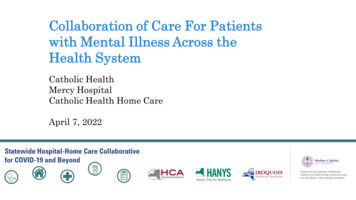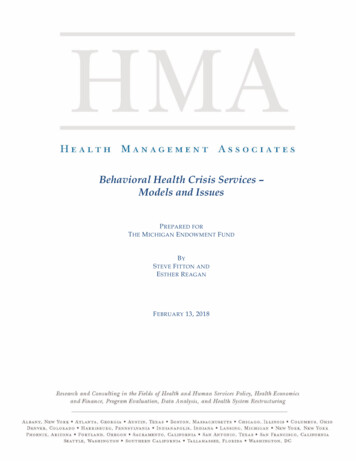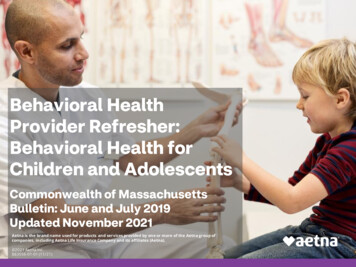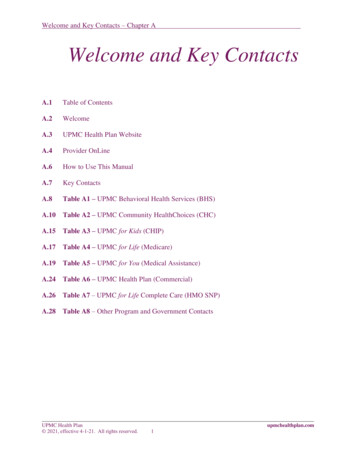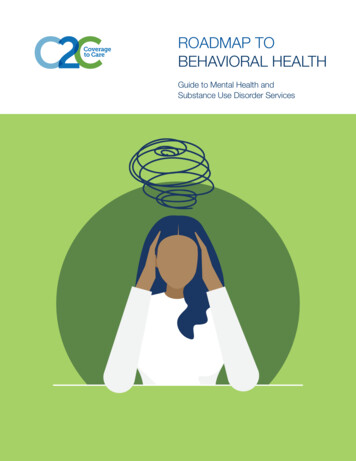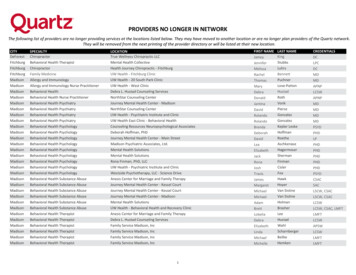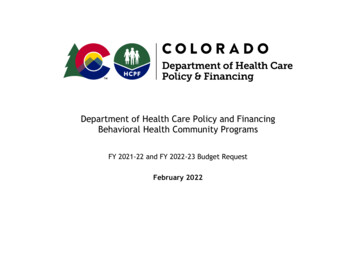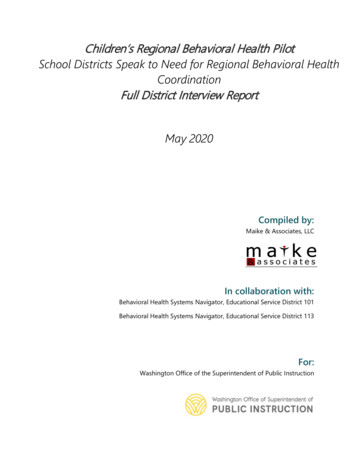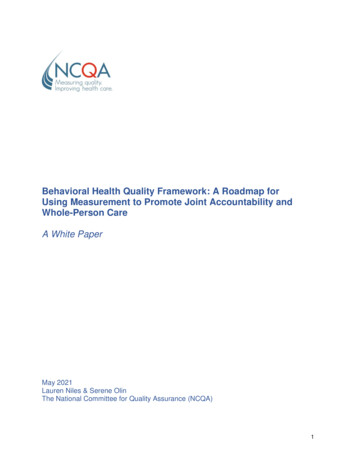
Transcription
Behavioral Health Quality Framework: A Roadmap forUsing Measurement to Promote Joint Accountability andWhole-Person CareA White PaperMay 2021Lauren Niles & Serene OlinThe National Committee for Quality Assurance (NCQA)1
In BriefMental health (MH) conditions and substance use disorders (SUD), collectively referred to in this report as“behavioral health (BH) conditions,” are a leading cause of disease burden in the United States,surpassing both cardiovascular disease and cancer.1 As of 2019, nearly 1 in 5 adults in the United Stateshad a diagnosed MH condition, and 1 in 12 people over the age of 12 had a diagnosed SUD.2 Individualswith BH conditions experience higher morbidity, poorer health outcomes, and a 20-year lower lifeexpectancy than the general population.3 These poorer outcomes occur even though care for people withBH conditions accounts for a disproportionate share of total health care spending. Payers andstakeholders are increasingly looking to value-based payment models to integrate BH and physical health(PH) care to improve outcomes and manage costs.The current fragmented and inequitable state of BH care calls for a quality measurement framework thatcan be used to guide and hold entities jointly accountable for improving care access and outcomes forindividuals with BH conditions. To guide development of this framework, the National Committee forQuality Assurance (NCQA) employed a mixed-methods approach involving an environmental scan andkey stakeholder interviews to evaluate the current BH quality measurement landscape and betterunderstand the needs and challenges of entities responsible for BH care across the health care system.FindingsAn environmental scan of 39 active federal programs that collectively use over 1,400 quality measuresand metrics uncovered the following: Federal programs, especially those focused on BH care, rely heavily on metrics andnonstandardized quality measures, limiting use for benchmarking and value-based paymentmodels. Standardized quality measures used in federal programs are a mix of BH and PH measures. Standardized BH quality measures used in federal programs focus on narrowly specified conditionsor processes and are misaligned and used variably across programs. Only 35 unique standardized BH quality measures were used across all federal programs; 16were used only in a single program. Four measures were most frequently used across programs: Follow-Up After Hospitalization forMental Illness; Screening for Depression and Follow-Up Plan; Initiation and Engagement ofAlcohol and Other Drug Abuse and Dependence Treatment; Preventive Care and Screening:Tobacco Use—Screening and Cessation Intervention. BH integration is inconsistently and insufficiently measured by current standardized measures.Key stakeholder interviews with entities operating at different levels of the delivery system in five diversestate Medicaid models that participate in federal programs yielded the following insights about the currentuse of quality measures for delivery, management, and improvement of care for populations with BHneeds: BH care is supported through a complex assortment of funding streams, often to augmentinadequate BH coverage with ancillary services. Current BH quality reporting efforts are burdensome and limit resources for improving andmeasuring aspects of BH care most meaningful to different levels of the delivery system. Entities across the delivery system have unique and unmet quality measurement needs, asillustrated in the table below (Meaningful Aspects of BH Care Quality). BH integration is viewed as key to addressing access and stigma, but entities are unclear on who isaccountable for driving integration and how to measure its quality. Large-scale solutions and incentives are seen as necessary to improve BH data challenges. Existing BH quality measures have challenged efforts to monitor quality during COVID-19.2
Meaningful Aspects of BH Care Quality, by Delivery System LevelStateManagedCareFacilityXXXPatient goal attainmentXXPatient experienceXXMeasure CategoryPROCESSESOUTCOMESBH symptom and functioning improvement (i.e.,measurement-based care)Social outcomes (e.g., kindergarten readiness, crime rate,employment rate)XBH integration—outcomes and effectivenessXXCostXXEquity in BH outcomesXXXSocial service coordination (e.g., link to social service agency)XXHealth care coordination/referral successXXEvidence based treatment (e.g., Fidelity to CognitiveProcessing Therapy model)XPatient goal settingXBH integration—processes (e.g., data sharing, warmhandoffs)Equity (e.g., equitable access to BH care)XXXXXXXXRecommendationsTo drive improvements in BH quality and promote joint accountability across entities responsible forserving individuals with BH needs, we propose a BH Quality Framework, adapted from the ApplegateAlignment Model. This framework prioritizes alignment and use of meaningful sets of quality measures,uniquely targeted to each level of the health care system, that coordinate and assess progress towardspopulation-level goals. Bundles of measures and metrics are transparently defined, measured, andcoordinated, and data use is based on each entity’s unique position and relationship with respect to goalsand populations served. The illustration below shows how this framework can be applied to promotecollaboration and joint accountability for whole-person care.BH Quality Framework: Approach for Aligning Measures Across Levels of a Delivery System3
To support implementation of the BH Quality Framework, we propose a roadmap that includes threeprimary components:1. Identification of population goals and priority populations, with a strong focus on care equity,2. Purposeful, coordinated alignment of measures and metrics across different levels of the deliverysystem to drive common goals, and3. Alignment of policies and payment models to support and sustain efforts.Roadmap to Joint Accountability for Behavioral Health: BH Quality FrameworkFederal and state entities are positioned to drive improvements in BH care and impact population healthgoals by setting priorities and directing resources through regulations and financial support—butstakeholders, organizations, and individuals at all levels of the delivery system play a critical role. The BHQuality Framework calls for convening a diverse group of stakeholders that includes state policymakers,payers, providers, and consumers to jointly prioritize population goals for BH, develop relevant measurebundles, and address known inequities in care that stymie progress toward high-quality BH care.By aligning and coordinating efforts across the delivery system, meaningful quality measures can spuraccountability through transparency and payment. Purposeful alignment and coordinated qualitymeasurement activities that consider each entity’s sphere of influence while keeping a line of sight toshared goals can empower stakeholders to make informed decisions and minimize burden. There haverecently been momentous federal and state investments to help mitigate the COVID-19 pandemic’simpact on BH, but there is a critical need for a clear framework and approach to driving and measuringBH care quality and outcomes. The BH Quality Framework provides a testable model for guiding theseefforts.4
AcknowledgmentsBehavioral Health Quality Framework: A Roadmap for Using Measurement to Promote JointAccountability and Whole-Person Care was supported by the California Health Care Foundation (CHCF),which works to ensure that people have access to the care they need, when they need it, at a price theycan afford. Visit www.chcf.org to learn more.Special thanks to the individuals representing the 21 entities across California, Washington, Colorado,Louisiana, and Pennsylvania who volunteered their time to participate in this work.We would also like to acknowledge the input of NCQA staff, including Sarah Hudson Scholle, SepheenByron, Kristine Toppe, and Jennifer Lenz.Further, we would like to thank the members and NCQA staff organizers of NCQA’s Public SectorAdvisory Council who provided early input on the findings of this work.We are also grateful to the following individuals who provided comments and insights to preliminary draftsof interview guides and/or products along the way: Molly Finnerty (NYS Office of Mental Health),Catherine Teare (CHCF), Tanya Dansky (MemorialCare Medical Group).This paper was authored by NCQA staff:Serene Olin, PhD,Assistant Vice PresidentResearch and AnalysisLauren Niles, MPH, DrPH CandidateSenior Research AssociatePerformance MeasurementWe would also like to acknowledge the substantial contributions of Joe Castiglione and Tam NguyenLouie, who were part of the core team at NCQA. We are also grateful to Sarah Laurie, MPH, Health CareAnalyst, who supported data analysis for the environmental scan, and Raesah Ettawil, MPA, AssistantDirector, who supported writing the state profiles.CHCF Contract Officer: We are grateful for the support and guidance of Katherine Haynes, MBA, SeniorProgram Officer, People-Centered Care, CHCF.5
ContentsSection 1: The Challenge of Measuring BH Care Quality . 7Section 2: Environmental Scan. 8Section 3: Key Stakeholder Interviews with States participating in Federal Initiatives . 12Section 4: Recommendations and Next Steps . 19A Need for a System Framework. 19Proposed Roadmap to Joint Accountability: Applying the BH Quality Framework . 20Conclusion . 23Appendix . 25Appendix A: Environmental Scan Supplemental information . 25Appendix B: State Profiles . 29California . 29Washington . 30Colorado . 30Pennsylvania . 31Louisiana . 32Appendix C: Stakeholder Interview Methods . 33References. 346
Section 1: The Challenge of Measuring BH Care QualityState of behavioral health care in the United StatesMental health (MH) conditions and substance use disorders (SUD), collectively referred to in this report as“behavioral health (BH) conditions,” are a leading cause of disease burden in the United States,surpassing both cardiovascular disease and cancer.4 As of 2019, nearly 1 in 5 adults (51.5 million) in theUnited States had a diagnosed MH condition, and 1 in 12 (20.4 million) individuals over the age of 12 hada diagnosed SUD.5Individuals with BH conditions experience higher morbidity, poorer health outcomes, and lower lifeexpectancy than the general population. The excess in mortality—particularly among those with severemental illness—has been referred to as a “public health scandal.”3,6,7 This inequity reflects several factors,including higher risks for chronic diseases (including cancer), higher rates of accidental andnonaccidental deaths, and poorer access to medical care among those with BH needs, compared to thegeneral population.8 Yet despite the high prevalence and social and economic impact of BH in the UnitedStates, only 12% of individuals with SUD and 45% with MH receive specialty services, underscoringpervasive challenges to care access and coordination.5Disparities in access to and engagement in BH care also disproportionately impact communities of color.9The COVID-19 pandemic has exacerbated these disparities: Black and Latinx communities both suffer agreater COVID-19 disease burden and worse access to BH services. 10State and federal policy solutions to address these challenges include BH parity; expansion of Medicaid;efforts to integrate BH with medical care; and broad legislation related to improving access to treatmentfor MH and SUD (e.g., 2018 Substance Use-Disorder Prevention that Promotes Opioid Recovery andTreatment [SUPPORT] for Patients and Communities Act). The BH crisis, worsened by the COVID-19pandemic, brought about additional policies to promote BH care access (e.g., Coronavirus Aid, Relief,and Economic Security [CARES] Act, American Rescue Plan Act of 2021).11,12,13Tackling BH to manage health care costsAs national health care reform efforts focus on reducing costs and increasing efficiency, the spotlight hasshifted to variations and inequities in care and cost across health conditions and settings. Individuals withcomorbid SUD and MH conditions have been identified as a high-need, high-cost group that accounts fora disproportionate share of total health care spending across publicly and commercially insured lives.14And BH conditions have an outsized impact on medical costs: The average cost of treatment for medicalconditions is between 2.8 and 6.2 times higher for individuals with BH conditions than for those withoutBH conditions.14 Although individuals with BH conditions account for more than half of all health carespending, BH services account for only 4.4% of this cost.14 Payers and stakeholders are increasinglylooking to value-based payment models and opportunities to integrate BH and physical health (PH) careto improve outcomes and manage costs.15,16Role of quality measurementQuality measures provide information about health care quality, evaluate the impact of policies andservice delivery initiatives on care quality, and inform stakeholder decisions. Impactful quality measurescan be leveraged to create accountability through transparency (public reporting) and can be incorporatedinto payment programs to drive improvement in care quality. Although quality measures to assess MHand SUD care are available, there is a paucity of measures for many important conditions and relevantoutcomes, a limited focus on high-need, high-cost populations, and limited use in quality improvementand value-based payment programs. Among the MH and SUD measures used in accountabilityprograms, the average performance has remained stable or has declined over time.17 These trends inperformance stand in contrast to trends in PH measures, which have shown modest incremental gainsover the same period.17As national efforts evolve to pay for value rather than volume, value-based payment models that areguided by robust quality measures are urgently needed to support equitable, coordinated care for7
underserved populations with BH needs. Unfortunately, investment in BH quality measurement haslagged behind investment in other areas of health, adding to existing challenges to improve BH carequality.18 There is a clear need for investing resources in evaluating, implementing, and developing ameaningful and coordinated set of measures to drive improvements in BH care quality and outcomes.17,18Calls for a behavioral health care delivery frameworkThe current fragmented and inequitable state of BH care delivery and management calls for ameasurement framework that can be guide and hold entities jointly accountable for improving care accessand outcomes for individuals with BH conditions.To guide development of such a framework, the National Committee for Quality Assurance (NCQA)employed a mixed-methods approach to evaluate the current BH quality measurement landscape andgain a better understanding of the needs and challenges of entities that are responsible for BH careacross the delivery system. Specifically, this report provides a synthesis of insights gained from:1. An environmental scan and gap analysis of BH measures and metrics used in active federalprograms.2. Key stakeholder interviews about the current use of quality measures for the delivery,management, and improvement of care for populations with BH needs.The sections below provide an overview of the findings from this work, as well as the resultingrecommendation and accompanying roadmap for use of a BH Quality Framework to achieve jointaccountability across entities responsible for serving individuals with BH needs.Section 2: Environmental ScanFederal agencies are engaged in both funding and subsequent oversight of a large proportion of BH caredelivery through direct contracting, accountability programs, demonstration programs, and accreditations.To better understand how the quality of BH care and management is evaluated by federal agencies, ourenvironmental scan and gap analysis focused on BH quality measures used in Federal ReportingPrograms (see callout box for definition).Through a web-based search of all federal agency sites,conducted in October 2020, NCQA identified 86 FederalReporting Programs. Of these, we analyzed 39 activeprograms that were national in scope and includedstandardized reporting requirements for assessing carequality (see Appendix A for details). Among theseprograms, 6 focused on BH care (e.g., Section 1115 SUDDemonstration program), 27 focused on general medicalcare (e.g., Medicare Shared Savings Program), and theremaining 6 focused on integrated BH and medical care,hereafter called “behavioral health integration (BHI)” (e.g.,Certified Community Behavioral Health Clinic program).What is a Federal Reporting Program?Initiatives funded through federal agencies(e.g., Centers for Medicare & MedicaidServices) that disperse funds to entitiesoperating in the health delivery system toincentivize improvements in care delivery,management, or quality. These initiativescan take the form of active demonstrations,value or alternative based paymentinitiatives, accreditations, or certifications.For more information on our selectioncriteria and the programs identified, seeAppendix A.8
To characterize the reportingrequirements used by federal programs toassess care quality, NCQA categorizedand defined measures as standardizedquality measures, nonstandardized qualitymeasures, and metrics (see callout boxfor definitions). Standardized qualitymeasures, which have been inventoriedthrough the National Quality Forum (NQF)endorsement process19 or included in theCenters for Medicare & Medicaid ServicesMeasures Inventory Tool (CMIT),20 werefurther categorized into three domains:BH, PH, and cross-cutting. The “crosscutting” measure designation includedconcepts such as family or patientperceptions of care, care continuity andcoordination, patient safety, and socialdeterminants of health.Defining data used in Federal Reporting ProgramsStandardized quality measures: Data used to quantify andcompare the quality of health care in a standardized andstructured way. In this study, standardized quality measureshave undergone testing and have been endorsed by NQF orhave met criteria for inclusion in the CMIT. They includespecifications that allow comparison across entities orprograms.Nonstandardized quality measures: Data used to quantifyand compare the quality of health care in a structured way.Data are not NQF-endorsed or included in CMIT.Metrics: Data used to monitor progress toward programimplementation or goals; for example, utilization of servicecounts or counts of patients who have engaged in a particularservice. Unlike measures, metrics may not allow apples-toapples comparison across entities due to lack ofstandardization and specification.Key insights about the state of quality measurement across Federal Reporting Programs are detailedbelow.Key Insight 1: Federal programs, especially those focused on BH care, rely heavily on metrics andnonstandardized quality measures.Of the 1,410 measures and metrics used across the 39 Federal Reporting Programs included in thisstudy, 48% were standardized quality measures, 13% were nonstandardized quality measures, and 39%were metrics (Figure 1). Notably, BH and BHI programs included a higher proportion of metrics (85% and57%, respectively) than general medical programs (19%), and a lower proportion of standardized qualitymeasures (10% and 39%, respectively) than general medical programs (62%) (Figure 1).Figure 1: Federal Reporting Programs: Data Reporting RequirementsNumber ofProgramsMedian Numberof Measures &Metrics perProgramRange ofNumber ofMeasures &Metrics perProgram396276243717231-21716-1271-2175-559
Differences were also identified in the number of measures and metrics required for reporting amongprogram types. Overall, BH programs were found to be more burdensome, with a higher median numberof required measures and metrics than general medical programs and BHI programs (Figure 1). Commonmetrics in BH and BHI programs measure cost, program enrollment, network adequacy, diagnoses,service utilization, and patient and caregiver experience.These findings suggest that existing standardized quality measures may not meet the needs of BH andBHI programs and their stakeholders, and reliance on metrics or nonstandardized quality measures limitstheir usefulness in benchmarking programs and/or value-based payment models.Key Insight 2: Standardized quality measures used in Federal Reporting Programs include a mix of BHand PH quality measures.Following our review, we found that standardized measures selected for use in programs mirroredprogram goals (programs focused on BH included a higher proportion of BH measures) (Figure 2).Programs generally employed a mixture of BH, PH, and cross-cutting measures, suggesting that theymay be working to foster whole-person care through reporting. Cross-cutting measures identified inprograms captured data on patient experience, social service access, patient safety, cost, and carecoordination. The highest proportion of cross-cutting measures (34% of standardized quality measures)was found in BH programs, compared to general medical programs (17%) and BHI programs (14%).Figure 2: Standardized Quality Measures, by Measure TypeKey Insight 3: Standardized BH quality measures used in Federal Reporting Programs focus on narrowlyspecified conditions or processes and are misaligned and used variably across programs.We identified 35 unique standardized BH quality measures across federal programs. Of these, 31 (86%)were process measures, 1 was an intermediate outcome measure and 3 were outcome measures. Wedid not identify any BH structural measures. Most measures were narrowly specified and related toevidence-based treatment processes for specific BH conditions (e.g., depression, schizophrenia). Mostrelied on administrative claims data. A few used patient-reported data for screening, symptom monitoring,or functional status monitoring. These findings are consistent with other published findings related to gapsin quality measurement for BH, including those identified by Pincus et al.17 and Patel et al.21Figure 3 shows how frequently the 35 unique standardized BH quality measures are used across the 39identified federal programs. Of the 35 BH measures, 16 were used only once. Single-use measuresvaried with regard to the population of focus (e.g., depression, dementia, SUD) and intent (e.g., symptomassessment, screening, monitoring smoking abstinence).10
Figure 3: Use of the 35 Unique Standardized BH Quality Measures Across Federal ProgramsNotably, four standardized BH quality measures were most frequently used in federal programs (Table 1).All assess narrow care processes and rely on administrative claims data and focus on screening fordepression and tobacco use, SUD treatment access, and follow-up after acute hospitalizations for mentalillness. Together, these efforts suggest federal priorities to incentivize broader aspects of BH care (e.g.,patient-reported outcomes) or the use of more granular clinical data from electronic systems to improveBH care delivery, and quality may be hampered by limitations of existing standardized measures andreporting capabilities. Consequently, insights about care for a wider range of BH conditions, treatments,and outcomes are limited.Table 1: Most Frequently Used BH Quality Measures Across Federal Reporting ProgramsNumber ofFederalProgramsMeasure Used rceFollow-up After Hospitalizationfor Mental Illness130576NCQAProcessClaimsScreening for Depression andFollow-Up Plan110418CMSProcessClaims,RegistryInitiation and Engagement ofAlcohol and Other Drug Abuseor Dependence Treatment110004NCQAProcessClaimsPreventive Care and Screening:Tobacco Use: Screening andCessation Intervention80028NCQAProcessClaims11
Overall, the narrow focus of existing standardized BH quality measures, high frequency of single-usemeasures, and variability of measure use across programs suggest significant opportunity to better alignefforts to both reduce waste and improve coordination in the quality measurement landscape.Key Insight 4: BH integration is inconsistently measured across BHI Federal Reporting Programs, andefforts lack measures of critical aspects of whole-person care.The increasing focus on integrating BH and PH care as a way to address challenges in BH care accessand quality has led to calls for implementation of national quality measures related to BHI.17 We thusexamined, in detail, the six federal programs aimed specifically at BHI (Appendix A). Among theseprograms, we saw higher reliance on metrics—rather than on standardized quality measures—to assessquality and hold reporting entities accountable (57% and 39% of data collected in BHI programs,respectively) (Figure 4). This finding may suggest a paucity of relevant or feasible standardized qualitymeasures from which to select for use in programs and a lack of alignment across the health care systemfor how to best evaluate BHI.Figure 4: Reporting Requirements in BH Integration ProgramsA review of the standardized quality measures used in federal BHI programs (summarized in Appendix A)resulted in insights. First, measures used in these programs predominantly focused on narrow processesand relied on administrative claims data. Second, across all BHI programs, no quality measures assessedaccess to social services, integrated care practices, organizational structure, or cost of care—all criteria ofhigher levels of integrated care, as defined by the SAMHSA Center for Integrated Health Solutions. 22Third, quality measures related to care coordination (e.g., Closing the Referral Loop: Receipt of SpecialistReport), a critical component of BHI, were infrequently seen. These notable gaps in standardized andstructured quality measures in BHI programs limit the ability to assess the effectiveness of the programs’efforts and ascertain if they are driving and incentivizing whole-person care.Section 3: Key Stakeholder Interviews with States Participating in FederalInitiativesTo enrich environmental scan insights on the role of quality measurement in driving BH care, weconducted a series of key stakeholder interviews that focused on state Medicaid systems. Medicaid is thelargest single payer of BH services and state Medicaid programs represent an area of both innovationand financial model diversity. Ultimately, five exemplary diverse states were selected for inclusion.The five states—California, Washington, Colorado, Louisiana, and Pennsylvania—were selected tooptimize 1.) geographic variation, 2.) diversity in financial models for BH care delivery, and 3.) innovationin BH, according to an index of their participation in BH or BHI Federal Reporting Programs. Table 2highlights the characteristics of each state’s BH care delivery model. Appendix B contains information oneach state’s Medicaid delivery model, how each state incentivizes and assesses the quality of BH care,and current innovation regarding BH care delivery and management.12
Table 2: Description of State BH Medicaid sianaState Medicaid 9%Carve-inBH carve-outBH carve-outCarve-inProportionMedicaidBudget for BHMedicaid BH Coverage and ManagementBH FinancingModel: CarveIn/OutDifferentiationby BH SeverityBH PaymentModelEntityResponsiblefor BH CareManagement &CoordinationTraditionalspecialty carveout for SMI/SEDand SUDYNNNN (exceptCoordinatedSystem of Carefor children)VBP: Mild/ModFFS: SMI, SUDVBPVBP for BH(vs. FFS for PH)VBP and FFSVBPRegionalAccountableEntitiesBH MCOs,throughcontracts withcounties (orstate office ofMH andSubstanceAbuse Services,if county optsout)Managed CareEntitiesCounty MHplans (specialty)and managedcare plans (nonspecialty)MCOs(integrated) or“BH ServicesOnly” contractsthrough MCOsBH Behavioral Health; MH Mental Health; PH Physical Health; SMI Serious Mental Illness;SED Severe Emotional Disturbance; VBP Value
5 Acknowledgments Behavioral Health Quality Framework: A Roadmap for Using Measurement to Promote Joint Accountability and Whole-Person Care was supported by the California Health Care Foundation (CHCF), which works to ensure that people have access to the care they need, when they need it, at a price they
